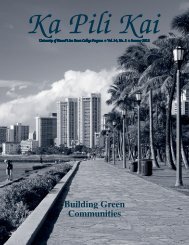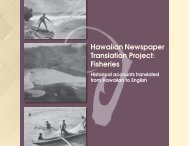Implementing the Reimaanlok Conservation Planning Process
Implementing the Reimaanlok Conservation Planning Process
Implementing the Reimaanlok Conservation Planning Process
Create successful ePaper yourself
Turn your PDF publications into a flip-book with our unique Google optimized e-Paper software.
<strong>Process</strong> Steps<br />
1. Define Purpose of Local and Traditional Knowledge Collection<br />
There are various reasons for <strong>the</strong> collection of local and traditional knowledge on natural resources in<br />
<strong>the</strong> RMI including:<br />
a. Identification of places and species that should be targets for conservation and management;<br />
b. Empowering communities and encouraging <strong>the</strong>ir participation in developing resource<br />
management plans for <strong>the</strong>ir atolls, including conservation plans and fisheries management<br />
plans, by acknowledging <strong>the</strong> existence and value of <strong>the</strong>ir knowledge; and<br />
c. Documenting and guarding against <strong>the</strong> loss of traditional knowledge and resource management<br />
practices as part of Marshall Islands heritage.<br />
Prior to a process for collecting information, it is important to be clear about <strong>the</strong> purpose and uses of<br />
<strong>the</strong> information. This will influence <strong>the</strong> following process. Consider <strong>the</strong> questions:<br />
• What will be done with <strong>the</strong> information? How will it be used?<br />
• Where and how will <strong>the</strong> information be stored?<br />
• Who will have access to <strong>the</strong> information?<br />
2. Preliminary Meetings with Iroij and Mayor<br />
The appropriate way to access <strong>the</strong> community is through traditional and elected leaders. In addition,<br />
<strong>the</strong>se leaders may <strong>the</strong>mselves have good knowledge of <strong>the</strong> resources on <strong>the</strong>ir atolls. In particular, <strong>the</strong><br />
Iroij is a key source for information about mo.<br />
Preliminary meetings with <strong>the</strong> Iroij and Mayors should be held with <strong>the</strong> objectives:<br />
• To fully inform <strong>the</strong>m of <strong>the</strong> purpose of <strong>the</strong> information ga<strong>the</strong>ring,<br />
• To ga<strong>the</strong>r preliminary information on resources and mo, and<br />
• To gain access to knowledgeable people from <strong>the</strong>ir communities.<br />
More than one meeting will probably be required in order to meet all <strong>the</strong>se objectives. Meetings may<br />
also include advisors and representatives of <strong>the</strong> Iroij or Mayor.<br />
3. Setup Workshop/ Meeting<br />
a. Invite informants<br />
Make sure informants know <strong>the</strong> date, time and location. Make reminder phone calls. Direction<br />
from <strong>the</strong> Mayor or Iroij to <strong>the</strong> informant will be helpful to ensure <strong>the</strong> informant has <strong>the</strong><br />
authority to give information.<br />
b. Prepare materials for workshop<br />
Arrange for maps or charts of <strong>the</strong> atoll for <strong>the</strong> workshop.<br />
Small format maps may be generated from <strong>the</strong> Marshall Islands <strong>Conservation</strong> GIS. Large format<br />
maps may be printed by RMIEPA or nautical charts may be used.<br />
Prepare forms for recording of <strong>the</strong> information.<br />
31
















